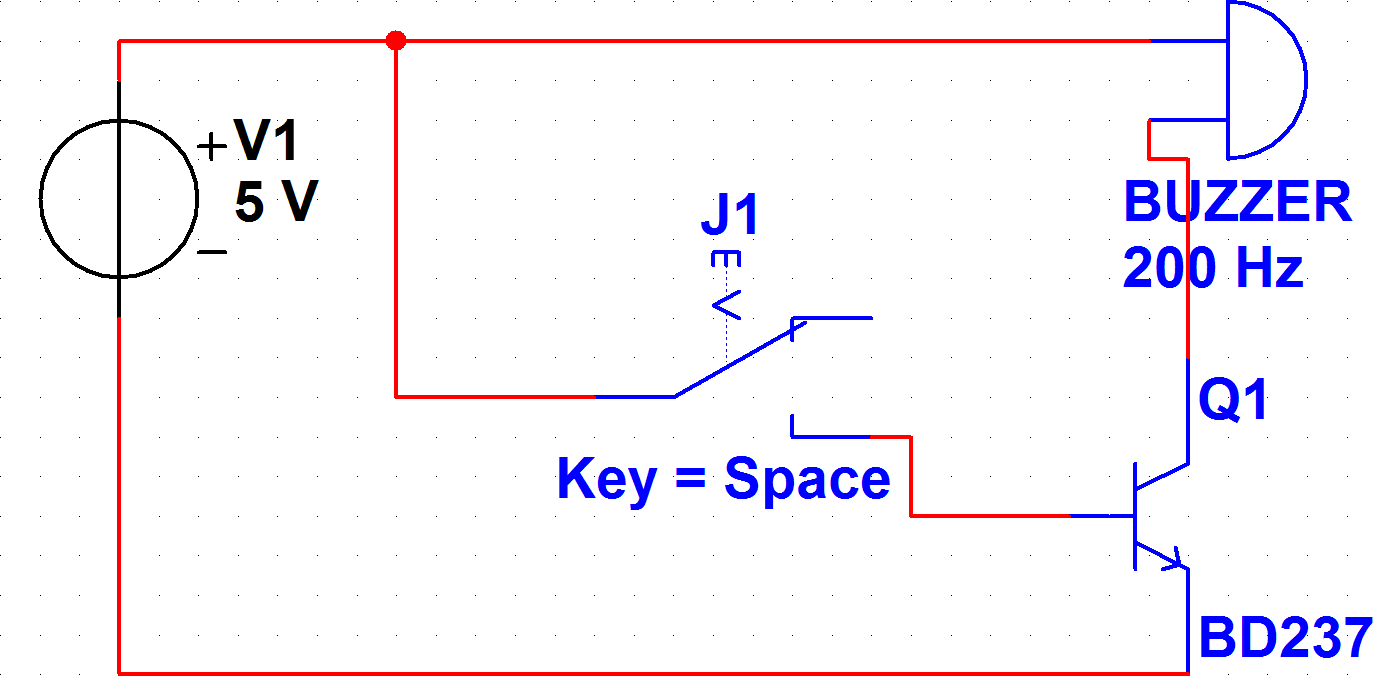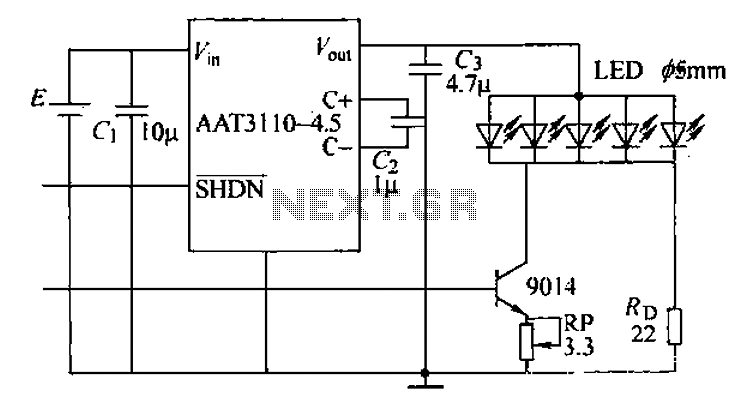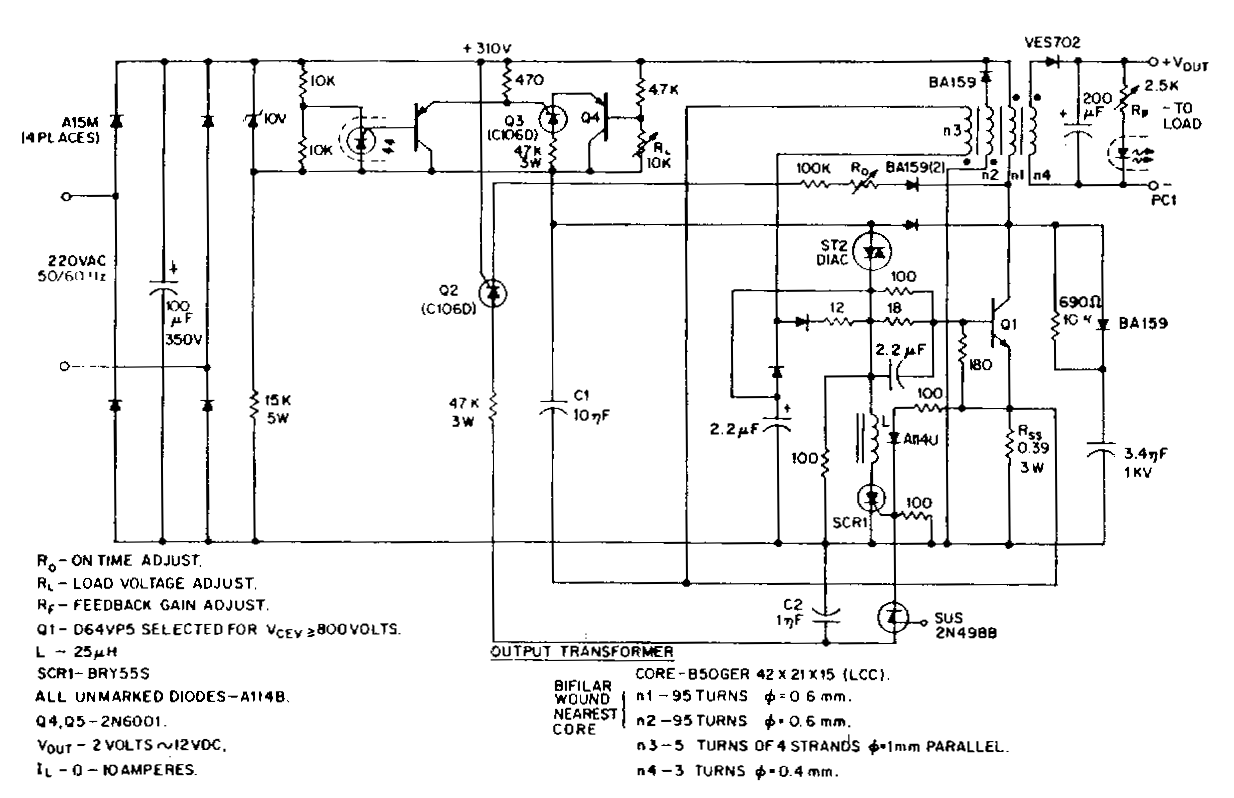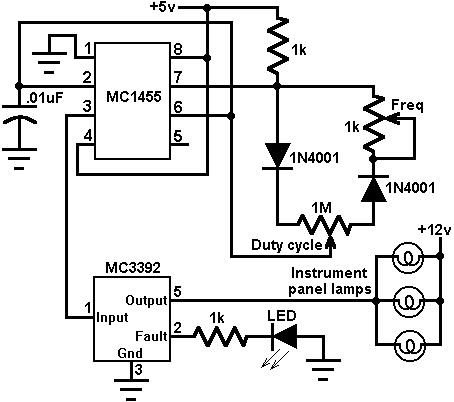
avr Control 5V buzzer using mcu and a single 5 V power supply

A PB-12N23PW-05Q buzzer is being used with an ATmega 162 microcontroller. Direct connection to the microcontroller pin is not feasible due to the maximum sourcing capability of 20 mA as stated in the ATmega 162 datasheet, while the buzzer requires 50 mA (or approximately 25 mA based on the graph). The initial approach involved using a transistor as a switch. A BD237 NPN transistor was selected, with the microcontroller's pin connected to the base, the buzzer connected to Vcc, the buzzer's negative terminal connected to the collector, and the emitter connected to ground. However, this configuration did not function as expected. Concerns were raised regarding the voltage drop across the transistor, which appears to be the primary issue. It was noted that the microcontroller does not have an internal resistor on the pin; it only specifies a maximum output current, which, if exceeded, could damage the device. It was recommended to use Ohm's law to determine an appropriate resistor value. A 1 KOhm resistor was suggested for the base of the NPN transistor. However, the voltage drop across the transistor (approximately 0.6 V) results in a voltage of about 4.4 V across the buzzer, which is outside the recommended operating range of 4.5 to 5.5 V according to the buzzer's datasheet. An alternative suggestion was to replace the NPN transistor with a MOSFET, such as the 2N7000, which has a lower on-resistance of 5 Ohms, resulting in a significantly lower voltage drop. Testing the buzzer with a bench power supply in the 4 V to 5 V range was recommended to determine its operational characteristics. It was also advised to measure the actual voltage across both the buzzer and the transistor, as there may be peak currents causing the power supply voltage to drop, potentially resetting the ATmega. Adding bypass capacitors or a ferrite bead could mitigate these issues.
The circuit involves utilizing a PB-12N23PW-05Q buzzer with an ATmega 162 microcontroller, necessitating careful consideration of the current requirements and voltage levels to ensure proper functionality. The buzzer's current draw exceeds the ATmega's maximum output capability, necessitating the use of a switching component. The chosen BD237 NPN transistor serves as a switch, controlled by the microcontroller's output pin. However, due to the inherent voltage drop across the transistor, the buzzer may not receive sufficient voltage for reliable operation.
To enhance performance, it is advisable to incorporate a base resistor (1 KOhm) between the microcontroller and the transistor's base. This resistor helps limit the base current, protecting the microcontroller from excessive current draw. The output from the transistor should be monitored to ensure that the voltage across the buzzer remains within the specified range of 4.5 to 5.5 V. If the voltage drop across the transistor is significant, switching to a MOSFET with lower on-resistance is recommended. The 2N7000 MOSFET, for instance, presents a more efficient solution, minimizing voltage loss and allowing the buzzer to operate effectively.
In practical applications, testing the buzzer with a variable power supply can provide insights into its operational characteristics. Observing the voltage levels with an oscilloscope can reveal potential issues such as voltage drops during peak current demands, which may lead to microcontroller resets. To address these concerns, adding bypass capacitors near the power supply lines can stabilize the voltage supplied to the microcontroller and the buzzer, while a ferrite bead or resistor can help filter out any high-frequency noise.
Overall, careful design considerations, including component selection and circuit configuration, will ensure that the buzzer operates reliably within the constraints of the ATmega 162 microcontroller.A PB-12N23PW-05Q buzzer and I`m trying to use it with ATmega 162. I can`t connect it directly to pin, because from what I`ve read from 162`s datasheet, it can source at most 20 mA. The buzzer takes 50 (or around 25, if we take a look at the graph), so I don`t think I can just directly connect it to the microcontroller.
My initial idea was to connect it to a transistor and use the transistor as a switch. Unfortunately, it didn`t work. I used BD237 and my idea was that the microcontroler will pull the pin connected to the base high and the transistor will operate the buzzer. In my setup, I had buzzer connected to Vcc, buzzer`s negative port connected to collector, GND connected to the emitter and 162 connected to the base.
Transistor is of NPN type. Somewhere I read that this way some problems related to the voltage drop on the transistor can be mitigated, but to me it looks like the voltage drop is the main problem here. @AndrejaKo The micro does not have a resistor inside the pin. It only has a maximum specified output current which, when exceeded, may release magic smoke. Use Ohm`s law to specify the resistor. joeforker Feb 14 `11 at 22:59 Thank you for posting and linking to exactly which sound-maker you are trying to use: the PB-12N23PW-05Q self-oscillating buzzer.
(If you had a raw piezo disk, or a coil speaker, we would use a different drive circuit). If you insist on using a NPN such as the BD237, you need to add a external resistor between the MCU and the base of the NPN, as joeforker mentioned: 1 KOhm should be adequate. But no matter what resistor or silicon NPN transistor you use, you will end up with (at best) a V_ce_sat voltage drop of around 0.
6 V, so the voltage across the buzzer is about 4. 4 V - which is technically outside the "guaranteed-to-work" "4. 5 to 5. 5 V" operating range in the buzzer datasheet. If I were you, I would probably throw out the NPN and replace it with a MOSFET. A cheap 2N7000 has an on-resistance of 5 Ohm; at 25 mA that gives a voltage drop of. 125 V. (More expensive MOSFETs have an order of magnitude less (better) on-resistance). Hook the buzzer up to a bench power supply, and see what it sounds like in the 4 V to 5 V voltage range. Perhaps it`s supposed to sound like that at that (5V - transistor drop) voltage What is the actual voltage across the buzzer and across the transistor I might check this with an O`scope, since it`s quite possible that we have an average current of 25 mA, as shown on the graph, but peak pulses of much higher current - perhaps such a high instantaneous current that your so-called "5 V" power supply is briefly pulled down to such a low voltage that your ATmega resets.
If that is the case, you`ll need to add some bypass capacitors and perhaps a ferrite bead or resistor. 🔗 External reference
The circuit involves utilizing a PB-12N23PW-05Q buzzer with an ATmega 162 microcontroller, necessitating careful consideration of the current requirements and voltage levels to ensure proper functionality. The buzzer's current draw exceeds the ATmega's maximum output capability, necessitating the use of a switching component. The chosen BD237 NPN transistor serves as a switch, controlled by the microcontroller's output pin. However, due to the inherent voltage drop across the transistor, the buzzer may not receive sufficient voltage for reliable operation.
To enhance performance, it is advisable to incorporate a base resistor (1 KOhm) between the microcontroller and the transistor's base. This resistor helps limit the base current, protecting the microcontroller from excessive current draw. The output from the transistor should be monitored to ensure that the voltage across the buzzer remains within the specified range of 4.5 to 5.5 V. If the voltage drop across the transistor is significant, switching to a MOSFET with lower on-resistance is recommended. The 2N7000 MOSFET, for instance, presents a more efficient solution, minimizing voltage loss and allowing the buzzer to operate effectively.
In practical applications, testing the buzzer with a variable power supply can provide insights into its operational characteristics. Observing the voltage levels with an oscilloscope can reveal potential issues such as voltage drops during peak current demands, which may lead to microcontroller resets. To address these concerns, adding bypass capacitors near the power supply lines can stabilize the voltage supplied to the microcontroller and the buzzer, while a ferrite bead or resistor can help filter out any high-frequency noise.
Overall, careful design considerations, including component selection and circuit configuration, will ensure that the buzzer operates reliably within the constraints of the ATmega 162 microcontroller.A PB-12N23PW-05Q buzzer and I`m trying to use it with ATmega 162. I can`t connect it directly to pin, because from what I`ve read from 162`s datasheet, it can source at most 20 mA. The buzzer takes 50 (or around 25, if we take a look at the graph), so I don`t think I can just directly connect it to the microcontroller.
My initial idea was to connect it to a transistor and use the transistor as a switch. Unfortunately, it didn`t work. I used BD237 and my idea was that the microcontroler will pull the pin connected to the base high and the transistor will operate the buzzer. In my setup, I had buzzer connected to Vcc, buzzer`s negative port connected to collector, GND connected to the emitter and 162 connected to the base.
Transistor is of NPN type. Somewhere I read that this way some problems related to the voltage drop on the transistor can be mitigated, but to me it looks like the voltage drop is the main problem here. @AndrejaKo The micro does not have a resistor inside the pin. It only has a maximum specified output current which, when exceeded, may release magic smoke. Use Ohm`s law to specify the resistor. joeforker Feb 14 `11 at 22:59 Thank you for posting and linking to exactly which sound-maker you are trying to use: the PB-12N23PW-05Q self-oscillating buzzer.
(If you had a raw piezo disk, or a coil speaker, we would use a different drive circuit). If you insist on using a NPN such as the BD237, you need to add a external resistor between the MCU and the base of the NPN, as joeforker mentioned: 1 KOhm should be adequate. But no matter what resistor or silicon NPN transistor you use, you will end up with (at best) a V_ce_sat voltage drop of around 0.
6 V, so the voltage across the buzzer is about 4. 4 V - which is technically outside the "guaranteed-to-work" "4. 5 to 5. 5 V" operating range in the buzzer datasheet. If I were you, I would probably throw out the NPN and replace it with a MOSFET. A cheap 2N7000 has an on-resistance of 5 Ohm; at 25 mA that gives a voltage drop of. 125 V. (More expensive MOSFETs have an order of magnitude less (better) on-resistance). Hook the buzzer up to a bench power supply, and see what it sounds like in the 4 V to 5 V voltage range. Perhaps it`s supposed to sound like that at that (5V - transistor drop) voltage What is the actual voltage across the buzzer and across the transistor I might check this with an O`scope, since it`s quite possible that we have an average current of 25 mA, as shown on the graph, but peak pulses of much higher current - perhaps such a high instantaneous current that your so-called "5 V" power supply is briefly pulled down to such a low voltage that your ATmega resets.
If that is the case, you`ll need to add some bypass capacitors and perhaps a ferrite bead or resistor. 🔗 External reference





